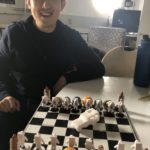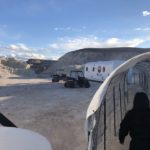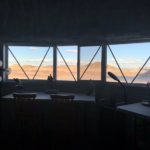
Crew 208 Medical Makers – Mission Summary
Commander: Julielynn Wong
Executive Officer: Dean Jin
Health & Safety Officer: David Kim
Engineer & Astronomer: Amanda Manget
GreenHab Officer & Journalist: Erika Rydberg
Medical Makers is a global community of innovators, patients, and healthcare providers who use low-cost technologies to make sustainable solutions to save lives, time, and money. Medical Makers host Medical Make-A-Thons worldwide to crowdsource low-cost, high-quality, life-changing 3D printable solutions for 3D4MD’s digital library.
Our MDRS mission dates were from March 28, 2019 to April 7, 2019. We completed a total of 7 EVAs.
Crew 208 Medical Makers Projects at MDRS
Project #1: 3D printing drone maps of MDRS and the surrounding Mars-like terrain
Crew 208 Medical Makers XO and GHO processed Crew 207 Medical Makers drone maps and 3D printed contour scale models of MDRS. Two 3D printed MDRS elevation models will be provided to the Mars Society.
Project #2: Testing a new drone controller designed by a retired NASA astronaut, physician, explorer, pilot, and inventor
Crew 208 Medical Makers compared the performance of a traditional and new drone controller during flight tests. Post-flight surveys were completed and qualitative feedback was obtained.
Project #3: Evaluating a low-cost, high-fidelity, 3D printed thoracentesis trainer designed to allow Crew Medical Officers, their back-ups, and healthcare professionals to attain and maintain life-saving surgical skills to serve astronauts on long space missions and the 5 billion people who lack access to safe, timely, and affordable surgical care
Five crew members used a low-cost, high-fidelity thoracentesis trainer 3D printed on-site to acquire or maintain life-saving procedural skills to decompress a tension pneumothorax on a simulated patient. Three performance metrics were measured; performance score, procedure time and learner’s confidence. Crew 208 Medical Makers data has been compiled for analysis and manuscript preparation.
Project #4: Demonstrating the technical feasibility of bike-powered 3D printing by six Martian analogue astronauts — who are following the International Space Station cycling ergometer schedule — to empower the 1 billion people without access to electricity to use portable 3D printing technologies and biodegradable plastic filament
Crew 208 Medical Makers showed that a renewable, green energy source can power a 3D printer to use biodegradable plastic to make customized medical devices that were previously printed on the ISS. Five crew members cycled for 1 hour per day for a total of 2 days per crew member on a bicycle to charge a battery that was used to power the 3D4MD 3D printing system. Crew 208 Medical Makers used this bike-powered battery to 3D print two customized mallet finger splints out of food-safe, biodegradable plastic. Crew 208 Medical Makers data has been compiled for analysis and manuscript preparation.
Project #5: Testing a wearable sensor that monitors wear time for 3D printed prosthetic hands to reduce the risk of complications
Crew 208 Medical Makers provided feedback on a wearable sensor prototype for 3D printed prosthetic hands.
Project #6: 3D printing essential items on demand locally to save lives, time and money for the 3.75 billion people who live in remote or rural areas, the 136 million people who require humanitarian aid, and astronauts on long space missions
Crew 208 Medical Makers 3D printed the following 3D4MD catalog items;
- A parameterizable funnel for the Médecins Sans Frontières/Doctors Without Borders Green Catalog and MDRS Greenhab
- Toy ambulances requested by Médecins Sans Frontières/Doctors Without Borders that are made out of biodegradable plastic that changes colour in sunlight or with temperature
Project #7: 3D printing low-cost, high-quality medical devices for healthcare providers who serve the 3.75 billion people who live in remote or rural areas and astronauts on long space missions
Crew 208 Medical Makers 3D printed the following 3D4MD catalog items;
- A ninja star two-point discriminator that meets Health Canada guidelines to diagnose and treat an injured astronaut on a long space mission
- An IV line protector requested by Médecins Sans Frontières/Doctors Without Borders
- A sexual and reproductive education model to promote HPV vaccination rates and reduce the risk of cervical cancer
Project #8: Testing a reusable and simple 3D printable ostomy system for stoma patients who cannot afford disposable ostomy appliances, a growing global industry that costs healthcare systems $2.5 billion a year
Crew 208 Medical Makers 3D printed two components of this ostomy system on-site at MDRS.
Project #9: Using reusable, personalized 3D printed straws made out of food-safe biodegradable plastic to conserve water at MDRS and reduce the amount of plastic waste in landfills and oceans
All five crew members were using 3D printed colored straws to identify their personal cups for re-use all day to conserve our water resources at MDRS.
Acknowledgements
Crew 208 Medical Makers is grateful for the financial support of Dr. Robert Milkovich and Mrs. Marijana Milkovich, Ron Rivkind at Filaments.ca, and Schulich Leader Scholarships, Canada’s most coveted undergraduate STEM scholarships. Our MDRS projects are also made possible thanks to Atila Meszaros, David Mateus, and Shannon Rupert at the Mars Desert Research Station, Dr. Scott Parazynski and George Guerrero at Fluidity Technologies Inc., Jade Bilkey, Crew 207 Medical Makers, and members of the Medical Makers YGK, YHM, YKF, YMM, YVR, YYT and YYZ Chapters.








You must be logged in to post a comment.